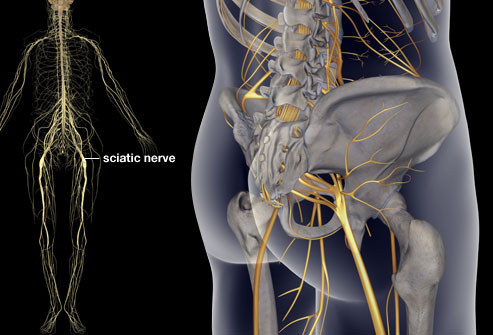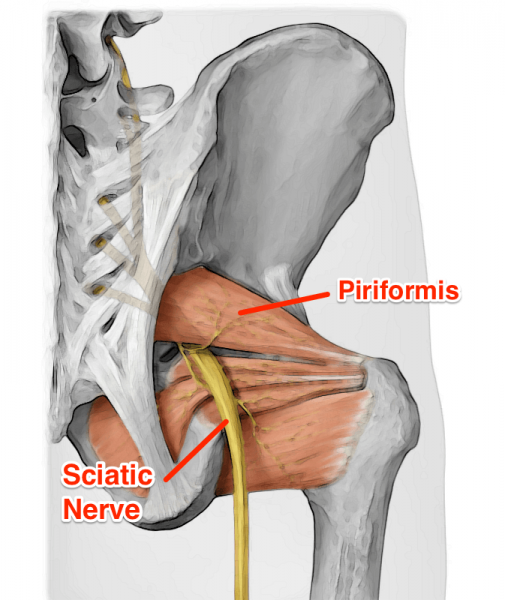Let’s Talk About Dancers’ Nerves… the Sciatic Nerve!
by Sally Harrison, Pro-Align and Strength4Dance
The sciatic nerve is one of the more commonly known nerves in the body.

It is one of the longest and largest nerves in the body and can be as thick as a thumb in some places. It forms from many nerve roots that exit the lumbar spine and then run down the back of the pelvis, hips and thigh. It then branches into two nerves called the tibial and common peroneal which travel to the foot.
The interesting part of this journey is the close proximity of the nerve to the piriformis muscle. For some people it actually runs through this muscle! This can mean that any tightness affecting the piriformis can have a direct effect on the nerve and its function. It can also be the source of sciatic nerve pain – better known as sciatica.
Sciatica is the term given to pain originating from the sciatic nerve. True sciatic pain will extend past the buttocks and down the leg and have a sharp sensation that can be quite debilitating.
Irritation of the nerve can be caused by many factors:
- Disc issues ⏤ A disc bulge can irritate the nerve root that leads to the sciatic nerve. The chemicals of inflammation can irritate the nerve sheath.
- Stenosis ⏤ Narrowing of the spinal canal caused by bone growth, thickened ligaments, fractures and arthritis can pinch the nerve root and affect the ability for it to glide in the spinal column.
- Spondylolisthesis ⏤ A small dysfunction in the pars of the spine from a birth defect or fracture, which leads to a step or slip of the vertebra forwards in relation to the one above. This is more common in younger adults that do a lot of back bends with reduced control of the spine and pelvis.
- Piriformis syndrome ⏤ Direct nerve irritation caused by the piriformis muscle (see above)
- Posture ⏤ non optimal posture creating changes in the space for the nerve to glide and altering resting and active muscle tension.

Warning!
Nerves don’t like to be stretched. They are not elastic in nature. Never push into the sensation of nerve stretch, pins and needles, numbness. Nerves do not like to lose their blood supply and if damaged take a really long time to recover.
Treatment
So what can we do if we think we have sciatic irritation? If you experience nerve pain down the back of the leg, whether it is constant or intermittent, you will need to see a practitioner to get a proper diagnosis. Depending on the diagnosis there are many things that can be done in clinic and at home. Such as:
- Massage to reduce muscular tension and help create space in the joints for the nerve to glide. This can be done with the treating therapist or with the roller and ball at home.
- Joint mobilisers and joint centring to create movement and space for the nerve to move easily and lessen the irritation and impingement. This will be done with the clinician.
- Posture training ⏤ allowing the body to find centre and have the joints in their optimal position for movement. For example, if the pelvis is tilted forward, the spine is in extension and the spaces smaller for the nerves to exit the spine.
- Core training ⏤ to stabilise the pelvis, spine and hip for movement. Piriformis connects the hip and pelvis together which is why it can be over worked.
- Strength training ⏤ creating more global stability for the trunk and efficient energy transfer to the hips. Happy spine = happy nerves!
Why?
As always we need to ask the why?
Why has the nerve become irritated? Is it coming from the spine or the hip muscles? Is it a stability issue or an impingement or inflammatory issue? Is there any disc pathology, and if so, why has the disc been irritated? What does your movement look like? Can your muscles switch on and off easily, or are you bracing?
You may be able to work some of this out yourself, but we normally want to work with a movement therapist or clinician. It can take time to really find the root cause of your back pain and movement dysfunction. You will need a good hour at least, with ongoing regular assessments in each session.
It is very useful to work with a clinician that has experience in dance training that can understand what you are required to do as part of your life as a dancer.
Nerves and flexibility! How is this linked?
The ability of the nerve to be able to glide easily within the body will directly affect flexibility. The sciatic nerve can have an effect on the flexibility we see in forward leg movement and even forward bending.
Neural gliding can be improved with directed muscle releases. This is easy to do with the ball in the back of the hip or even calf. We can also improve neural motion with flossing techniques. These are very easy and quick to do with great results.
You don’t need to be in pain to do neural flossing exercises. Keeping your nerve pathways fluid will help you daily flexibility and prevent injury. Bonus!
The video below shows an example of sciatic flossing. Assess your leg flexion range and then perform the flossing technique, and then re-assess. Remember with flossing with don’t want to stretch the nerve, we want to glide from one end to the other.
Enjoy your new flexibility and contact me if you have any questions about your nerves.
Sally xx
Pro-Align physiotherapy for dancers












